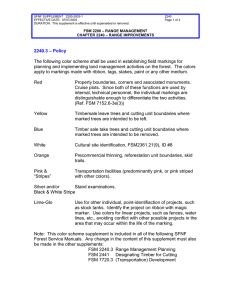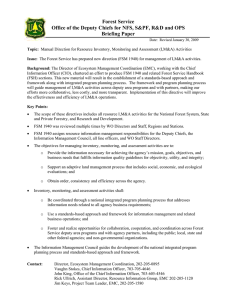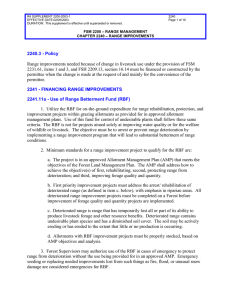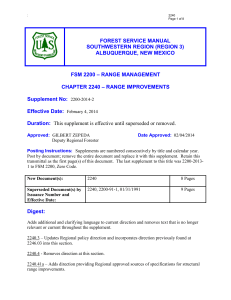R2 SUPPLEMENT 2200-2003-1 2240 EFFECTIVE DATE: 04/18/2003
advertisement
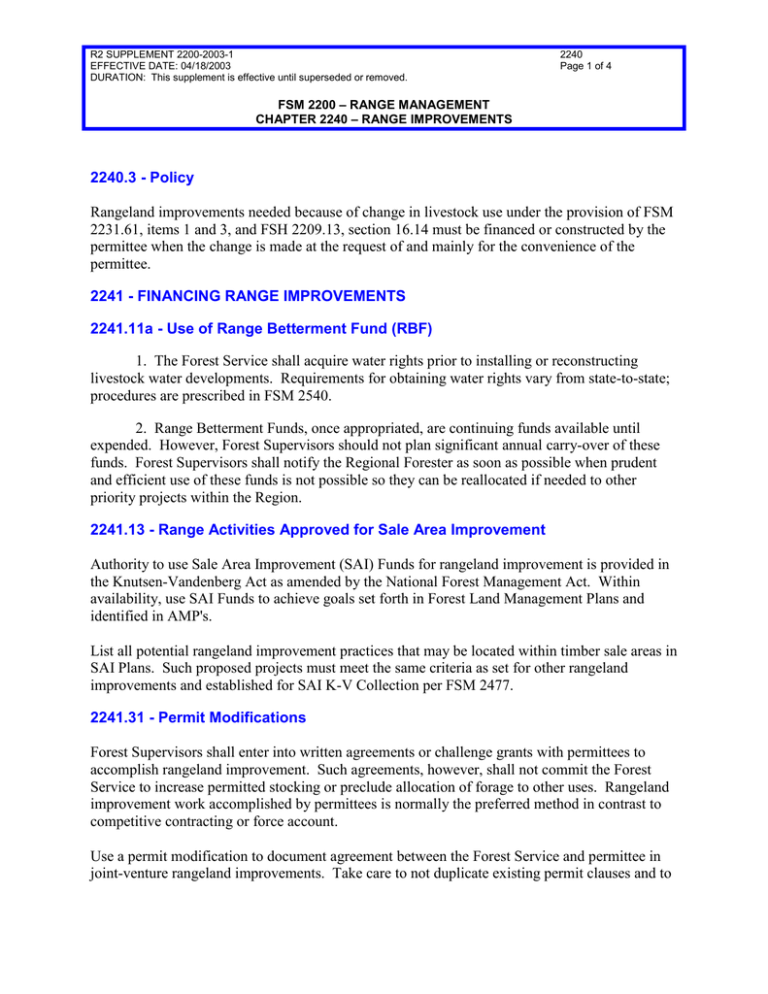
R2 SUPPLEMENT 2200-2003-1 EFFECTIVE DATE: 04/18/2003 DURATION: This supplement is effective until superseded or removed. 2240 Page 1 of 4 FSM 2200 – RANGE MANAGEMENT CHAPTER 2240 – RANGE IMPROVEMENTS 2240.3 - Policy Rangeland improvements needed because of change in livestock use under the provision of FSM 2231.61, items 1 and 3, and FSH 2209.13, section 16.14 must be financed or constructed by the permittee when the change is made at the request of and mainly for the convenience of the permittee. 2241 - FINANCING RANGE IMPROVEMENTS 2241.11a - Use of Range Betterment Fund (RBF) 1. The Forest Service shall acquire water rights prior to installing or reconstructing livestock water developments. Requirements for obtaining water rights vary from state-to-state; procedures are prescribed in FSM 2540. 2. Range Betterment Funds, once appropriated, are continuing funds available until expended. However, Forest Supervisors should not plan significant annual carry-over of these funds. Forest Supervisors shall notify the Regional Forester as soon as possible when prudent and efficient use of these funds is not possible so they can be reallocated if needed to other priority projects within the Region. 2241.13 - Range Activities Approved for Sale Area Improvement Authority to use Sale Area Improvement (SAI) Funds for rangeland improvement is provided in the Knutsen-Vandenberg Act as amended by the National Forest Management Act. Within availability, use SAI Funds to achieve goals set forth in Forest Land Management Plans and identified in AMP's. List all potential rangeland improvement practices that may be located within timber sale areas in SAI Plans. Such proposed projects must meet the same criteria as set for other rangeland improvements and established for SAI K-V Collection per FSM 2477. 2241.31 - Permit Modifications Forest Supervisors shall enter into written agreements or challenge grants with permittees to accomplish rangeland improvement. Such agreements, however, shall not commit the Forest Service to increase permitted stocking or preclude allocation of forage to other uses. Rangeland improvement work accomplished by permittees is normally the preferred method in contrast to competitive contracting or force account. Use a permit modification to document agreement between the Forest Service and permittee in joint-venture rangeland improvements. Take care to not duplicate existing permit clauses and to R2 SUPPLEMENT 2200-2003-1 EFFECTIVE DATE: 04/18/2003 DURATION: This supplement is effective until superseded or removed. 2240 Page 2 of 4 FSM 2200 – RANGE MANAGEMENT CHAPTER 2240 – RANGE IMPROVEMENTS be sure that all appropriate clauses are included in the permit modification as determined by the merits of each joint-venture project. Common practice is for permittees to donate labor and equipment and the Forest Service to furnish materials for structural improvements. These arrangements amount to each party furnishing approximately 50 percent of the total cost. Permittees can agree to assume responsibility for nonstructural and structural improvements where considerable dollar outlay is required, such as helicopter or other equipment hire. In cases where the Forest Service pays funds directly to the permittee, work with Grants and Agreements and Budget and Finance to determine the appropriate process and requirements. Seek advice from the unit procurement specialist before completion of the permit modification. 2242 - STRUCTURAL RANGE IMPROVEMENTS 2242.03 – Policy The Regional structural improvement specifications are found in the following three structural improvement handbooks: 1. Facilities for Handling, Sheltering, and Trailing Livestock. 8724-2809, September 1987. $5. 2. Fences. 8824-2803, July 1988. $12.50. 3. Facilities for Watering Livestock and Wildlife. MTDC 89-1, January 1989. $6. 4. Specifications for Structural Range Improvements. $7. These volumes can be ordered from: Society for Range Management, 445 Union Blvd., Suite 230, Lakewood, Colorado 80228-1259. 2243 - NONSTRUCTURAL RANGE IMPROVEMENTS 2243.03 – Policy For vegetation manipulation projects, site productivity, and site potential, are the key elements to determine possible treatment sites and treatment methodology. 1. Use site productivity and site potential in feasibility and site determination in the selection of nonstructural range improvement projects and in priority treatment determinations. 2. Integrate projects with other resources on the area as called for in the Forest Plan. R2 SUPPLEMENT 2200-2003-1 EFFECTIVE DATE: 04/18/2003 DURATION: This supplement is effective until superseded or removed. 2240 Page 3 of 4 FSM 2200 – RANGE MANAGEMENT CHAPTER 2240 – RANGE IMPROVEMENTS 4. Vegetative manipulation must consider all aspects of the problem. Develop the prescription through an interdisciplinary approach with priority given to having a hydrologist, soil scientist, and rangeland vegetation management specialist, along with other disciplines, as needed, working together in the field to obtain an optimum combination of benefits. 2243.33 - Insect and Disease Management 2243.33b – Cooperation Forest Supervisors should contact the Animal and Plant Health Inspection Service, USDA, when rangeland insect investigations or controls are desired. A control project, which extends into or is entirely within a Wilderness or Primitive Area, must be submitted to the Regional Forester for approval (FSM 2324.04b). 2244 - MAINTENANCE OF IMPROVEMENTS 2244.03 – Policy 1. The livestock permittee making use of the improvements is responsible for maintenance of structural range improvements. Responsibility for maintenance should not include those facilities installed for purposes other than management of permitted livestock (see item 3 below). 2. Structural range improvement designs and specifications are contained in the four handbooks listed in R-2 text 2242.03 and shall be used as a guide in maintenance of structural improvements. The condition level to which improvements should be maintained will vary depending on the location, purpose, and the number of years the improvement is expected to be needed. Most improvements will be needed indefinitely and should be periodically maintained at a level that will fully serve the intended purpose and perpetuate their life. Post, poles, and other timber products grown on National Forest System lands may be obtained free of charge subject to regulations and instructions. Where the condition of needed facilities has depreciated substantially below the desired level, consider replacement as re-construction. Scheduling for upgrading facilities or re-construction of existing and needed facilities will normally have priority over construction of other new improvements as follows. Where the permittee has responsibility for improvement maintenance and a lack of maintenance has resulted in an unsatisfactory condition, take action against the permit for non-compliance with the General Terms and Conditions of Part 2-(i) of the Term Grazing Permit. R2 SUPPLEMENT 2200-2003-1 EFFECTIVE DATE: 04/18/2003 DURATION: This supplement is effective until superseded or removed. 2240 Page 4 of 4 FSM 2200 – RANGE MANAGEMENT CHAPTER 2240 – RANGE IMPROVEMENTS When the condition of a facility is to be upgraded under the context of maintenance, the District Ranger and the permittee should develop an improvement schedule. This schedule shall be a part of the allotment management plan and should specifically point out the extent of participation by the permittee and the Government. In some cases, the condition of an improvement is partially or wholly so poor that maintenance is no longer practical. In these cases, the structure should be partially or totally disposed of and, if not replaced with new construction, deleted from the range improvement inventory record. Handle replacement as new construction making use of permit modifications as in FSM 2241.31. 3. Permittees' responsibility for maintenance should not include those facilities installed for purposes other than for management of livestock. Examples of non-livestock facilities include study enclosures, campground fences, wildlife guzzlers, plantation fences, and administrative improvements. Maintenance of cattle guards, bridges, and right-of-way fences on Forest Development roads shall be with Forest Road and Trail Funds (see FSM 6513.22b and FSM 2242). Forest Supervisors should ensure that Forest Service responsibility for maintenance is carried out in a quality and timely manner setting an example for permittees to follow.
